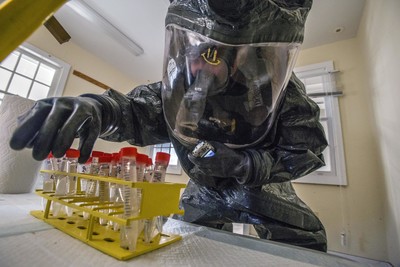
CRISPR is Making Bioweapons More Accessible
The 20th century was dominated by advances in physics that led to the development of the most destructive weapons humanity has ever created. Advances in biotechnology over the last few decades promise to make the same true for the 21st century. The biological revolution will produce new life-saving medicines and therapies, but it has also produced tools that could be turned into weapons of war. Synthetic biology, spurred by advances in genetic engineering technologies, is the latest in a series of biological advances that will fundamentally change how humans live and die.
Synthetic Biology: The Basics
Synthetic biology collectively refers to the concepts, tools, and approaches used to modify or create biological organisms. The most recent breakthrough in synthetic biology is a genetic engineering technique known as CRISPR-Cas9.
The first genetic engineering experiments took months to complete and cost millions of dollars to produce results that were often unsatisfying. CRISPR-Cas9 has changed the landscape, offering a relatively simple, low cost, speedy genetic modification tool. CRISPR-Cas9 has become so democratized that anyone can get everything they need to perform a simple genetic alteration delivered to their door for less than $300. It may seem exciting to have cutting edge biological tools available to everyone, but lack of oversight of these tools could be a danger to humanity.
Bringing the Lab to the Battlefield
Warfare has moved away from conventional weapons and towards asymmetric operations in the 21st century. The U.S.’ adversaries, particularly non-state terror groups, are looking for any opportunity to use limited resources to inflict maximum damage to the U.S. Advances in genetic engineering have offered them an opportunity to create a low cost, low profile, potentially catastrophic weapon of mass destruction; a bioweapon. Colonel Michael Ainscough highlighted the bioweapon threat in his paper for the USAF Air War College:
“Biotechnology has made it possible to inflict mass casualties using only small-scale special operations that can evade detection in attempt to avoid retribution. In asymmetric warfare, biological weapons are seen as a ‘great equalizer.’”
The National Academy of Sciences has put together a framework for assessing the threat posed by a synthetic bioweapon.
CRISPR-Cas9 has dramatically improved the usability of genetic engineering, lowering the barrier to entry for the average person both financially and technically. Much of the science is available for free on the internet, giving anyone with an internet connection and determination access to all of the knowledge necessary to successfully perform a genetic edit. Additionally, because CRISPR-Cas9 can be done in your kitchen, the operational footprint is quite small.
What’s left is how any particular application of CRISPR-Cas9 could be used as a weapon and what the potential is for mitigation. Scientists at the National Academy of Sciences have sorted potential applications into relative levels of concern.
The top three concerns share one particularly troubling characteristic; they’re the simplest applications of genetic engineering technology. Making existing bacteria more dangerous and altering organisms to produce different biochemicals are common lab practices around the world today. Recreating known viruses sounds difficult, but in 2002 scientists successfully recreated the Polio virus from only the publicly available genome and mail-order biomolecules. That experiment was conducted before the discovery of CRISPR-Cas9 and the method has only become easier in the intervening years.
The “Biological Century” Ahead
Everything discussed up to this point is possible today with limited resources and scientific know-how. Given more resources and a team of experts, like in a state-run lab, the possibilities are morbidly endless. Alan Shaffer, the Deputy Under Secretary of Defense for Acquisition and Sustainment, explained in his recent testimony to Congress that scientific advances are rapidly outpacing the ability to manage their consequences:
“Science is revealing the means to weaponize biology and chemistry in ways that were purely theoretical only 10 years ago. As we continue to move forward, it’s becoming increasingly apparent that creativity is our limit, not science.”
COVID-19 has proven how ill-equipped America is to deal with novel infectious diseases. The U.S. is currently constructing a facility that will allow the Department of Defense to rapidly develop and produce limited medical countermeasures to a bioweapon, but that’s a baby step compared to what’s needed. Improving interagency cooperation on public health infrastructure, collaborating with international partners, and imposing reasonable restrictions on the sale of key biomolecules needs to happen ASAP if we’re to contain the bioweapon threat.
Biotechnology is advancing far faster than the world around it. Failing to keep up with the pace of science when so much is at stake is not an option.






